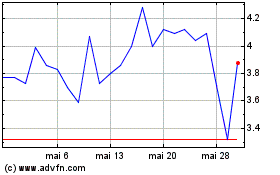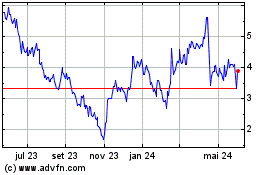Prelude Therapeutics Incorporated (Nasdaq: PRLD) (“Prelude” or the
“Company”), a clinical-stage precision oncology company, today
announced the presentation of additional data from its ongoing
Phase 1 open-label, dose-escalation trial of PRT3789, a
first-in-class, highly selective SMARCA2 degrader designed to treat
cancer patients with a SMARCA4 mutation. The data were presented at
a plenary session of the 36th Annual EORTC-NCI-AACR Symposium in
Barcelona, Spain.
The study investigators reported, as of September 23, 2024 (the
Cutoff Date), additional follow up data on 65 patients that were
enrolled, treated, and safety evaluable. PRT3789 was generally
well-tolerated through 8 dosing cohorts. The majority of adverse
events reported by investigators have been mild to moderate.
Overall, of the 26 advanced, heavily pre-treated NSCLC or
esophageal patients with Class 1 (loss of function) mutations
evaluable for efficacy, now with additional follow up, RECIST
partial responses (PRs) were confirmed in 4 patients, including 2
of 9 NSCLC patients with confirmed PRs at doses of 283 mg or
higher. As anticipated, higher doses are resulting in deeper and
more sustained SMARCA2 degradation in PBMCs. Additional patients
demonstrated clinical benefit as measured by prolonged stable
disease (SD) including one patient on treatment for more than a
year.
“We, along with our study investigators, are encouraged by the
promising activity shown to date by PRT3789 in this novel
first-in-class mechanism for patients who have limited treatment
options,” stated Jane Huang, M.D., President and Chief Medical
Officer of Prelude. “We look forward to further characterizing and
understanding the full potential of PRT3789 through ongoing
monotherapy dose escalation and in combination studies with both
docetaxel and pembrolizumab.”
PRT3789 Interim Phase 1 ResultsPRT3789 is
currently being evaluated in an ongoing dose-escalation Phase 1
trial in heavily pre-treated patients with advanced solid tumors
harboring any SMARCA4 mutation who have relapsed/refractory
disease. Sixty-five patients with advanced cancer were treated once
weekly via intravenous infusion at eight dose levels (24 mg, 48 mg,
80 mg, 120 mg, 160 mg, 212 mg, 283 mg, 376 mg), and follow up data
reported through to September 23, 2024. The median age of these
patients was 62 and the median number of prior treatments was 3
(ranging from 1-10). 34 patients (52.3%) presented with a Class 1
(loss of function) SMARCA4 mutation, while 24 patients (36.9%)
presented with a Class 2 (missense, VUS) SMARCA4 mutation and 7
(10.8%) had a loss of SMARCA4 protein.
Initial Safety DataPRT3789 was generally
well-tolerated. Treatment emergent adverse events of any grade
observed to date consisted of nausea (26.2%), fatigue (21.5%),
anemia (20.0%), decreased appetite (20.0%), abdominal pain (18.5%),
and constipation (18.5%). No dose limiting toxicities were observed
and no study drug-related serious adverse events were reported.
Pharmacokinetic (PK) and Pharmacodynamic (PD)
DataPreliminary PK data was available from 24 mg to 376 mg
dose cohorts. A general trend of increases in exposure (Cmax, AUC)
with dose was observed. Mean concentrations were observed above
SMARCA2 plasma DC50 (21 nM) for approximately 8 hours at the 376 mg
dose. No accumulation was observed with repeat dose administration,
consistent with the half-life and once-weekly administration. PD
effect (as measured by SMARCA2 protein levels in peripheral blood
mononuclear cells) observed was more prolonged than PK half-life.
Higher dose levels, above 212 mg, demonstrated a deeper, more
consistent, and more prolonged PD effect. SMARCA2 degradation was
observed in both peripheral blood mononuclear cells (PBMC) and in
available tumor tissue as shown through biopsy.
Analysis of Initial Clinical ActivityOf the 26
advanced NSCLC or esophageal patients with Class 1 (loss of
function) mutations who were evaluable for efficacy, RECIST
confirmed partial responses (PRs) were observed in 4 patients (2
esophageal, 2 NSCLC), including 2 of 9 NSCLC patients with
confirmed PRs at doses of 283 mg or higher. Tumor shrinkage was
observed in patients with both Class 1 and Class 2 SMARCA4
mutations. Additional patients on-study demonstrated clinical
benefit as measured by prolonged SD, including one advanced NSCLC
patient who remains stable and on study having been treated for
more than 1 year.
Initial observations of safety from evaluable patients in the
PRT3789 plus docetaxel combination dose escalation arm of the trial
were also presented. To date, PRT3789 in combination with docetaxel
demonstrated an acceptable safety profile, with no dose limiting
toxicities or study drug serious adverse events reported.
Additional SMARCA Degrader Presentations
The Company also provided two poster presentations at the
conference.
The Selective SMARCA2 Degrader, PRT3789, Counteracts the
Protective Cellular Stress Response to Chemotherapy and Enhances
the Efficacy of Standard of Care Chemotherapeutic Agents in SMARCA4
Mutant NSCLC Models
The combination of PRT3789 with standard of care NSCLC
chemotherapy agents significantly enhances anti-tumor activity in
preclinical models of SMARCA4-mutated NSCLC. Downregulation of
dominant gene pathways by PRT3789, specifically counters
docetaxel-induced upregulation of the E2F and G2/M pathways,
resulting in a more comprehensive cell cycle blockade and increased
apoptosis in SMARCA4-mutated cells. This synergistic activity was
observed with both Class I (loss of function) mutations and Class
II (missense) mutations.
Discovery of First-in-Class Precision Antibody Drug
Conjugates with a Potent SMARCA 2/4 Dual Degrader Payloads that
Safely Achieve Maximal and Tumor Specific Degradation and Efficacy
in Mouse Models
PRP0004 is a potent SMARCA2/4 dual degrader that robustly
inhibits cancer cell growth and induces cell death. Conjugation of
PRP0004 to clinically-validated antibodies yielded novel degrader
antibody conjugates (DACs), which demonstrated potent and
antigen-selective internalization and SMARCA2 and SMARCA4
degradation in cell lines derived from multiple cancers. Prostate
cancer cell lines were among the most sensitive to the PRP0004
degrader payload. PRP0004 downregulated multiple drivers of
prostate cancer cell growth and survival and resulted in cell
death, rationalizing the use of PSMA-targeting antibodies for
initial proof-of-concept studies in preclinical models.
As expected, dosing with PRP0004 on its own was highly
efficacious in prostate cancer xenografts but displayed a narrow
therapeutic window. However, when delivered as a payload on
anti-PSMA antibodies, the anti-PSMA SMARCA2/4 DACs demonstrate
robust SMARCA2 and SMARCA4 degradation and antigen-dependent
efficacy in xenograft models while being well-tolerated. These data
highlight the potential of this first-in-class precision ADC
approach utilizing a highly potent SMARCA2/4 dual degrader payload
to achieve maximal target degradation in tumors while sparing
healthy tissues. This strategy has the potential to significantly
expand the reach of Prelude’s novel SMARCA degraders to treating
patients without SMARCA4 mutations.
“Preclinical data presented today with our novel approach to
develop degrader antibody conjugates by using potent dual degraders
of SMARCA2 and 4 as payloads offers first proof-of-concept of
effectively and safely targeting an important mechanism to treat
cancers beyond those with SMARCA4 mutations” stated Peggy Scherle,
Ph.D., Chief Scientific Officer of Prelude.
All of the above noted presentations can be found at
Publications - Prelude Therapeutics (preludetx.com).
About PRT3789-01PRT3789 is a
first-in-class, potent and highly selective SMARCA2 degrader, in
Phase 1 clinical development in SMARCA4-mutated patients.
Enrollment remains on track, and the Company expects to conclude
monotherapy dose escalation by year end 2024 and identify the
biologically active dose to advance for future registrational
trials. In addition, enrollment of patients into back-fill cohorts
enriched for NSCLC and SMARCA4 loss-of-function mutations at higher
dose levels is ongoing. The objective is to assess clinical
activity in a more homogeneous group of patients with high unmet
need to support planned discussions with regulatory agencies. A
maximum tolerated dose has not yet been identified. Dose escalation
continues, now in the 10th dosing cohort (665 mg IV once
weekly).
About Prelude
Therapeutics
Prelude Therapeutics is a leading precision oncology company
developing innovative medicines in areas of high unmet need for
cancer patients. Our pipeline is comprised of several novel drug
candidates including first-in-class, highly selective IV and oral
SMARCA2 degraders, and a potentially best-in-class CDK9 inhibitor.
We are also leveraging our expertise in targeted protein
degradation to discover, develop and commercialize next generation
degrader antibody conjugates (Precision ADCs) with partners. We are
on a mission to extend the promise of precision medicine to every
cancer patient in need. For more information, visit
preludetx.com.
Cautionary Note Regarding
Forward-Looking Statements
This press release contains forward-looking
statements within the meaning of the "safe harbor" provisions of
the Private Securities Litigation Reform Act of 1995, including,
but not limited to, anticipated discovery, preclinical and clinical
development activities for Prelude’s product candidates, the
potential safety, efficacy, benefits and addressable market for
Prelude’s product candidates, and clinical trial results for
Prelude’s product candidates. All statements other than statements
of historical fact are statements that could be deemed
forward-looking statements. The words “believes,” “anticipates,”
“estimates,” “plans,” “expects,” “intends,” “may,” “could,”
“should,” “potential,” “likely,” “projects,” “continue,” “will,”
“schedule,” and “would” and similar expressions are intended to
identify forward-looking statements, although not all
forward-looking statements contain these identifying words. These
forward-looking statements are predictions based on the Company’s
current expectations and projections about future events and
various assumptions. Although Prelude believes that the
expectations reflected in such forward-looking statements are
reasonable, Prelude cannot guarantee future events, results,
actions, levels of activity, performance or achievements, and the
timing and results of biotechnology development and potential
regulatory approval is inherently uncertain. Forward-looking
statements are subject to risks and uncertainties that may cause
Prelude's actual activities or results to differ significantly from
those expressed in any forward-looking statement, including risks
and uncertainties related to Prelude's ability to advance its
product candidates, the receipt and timing of potential regulatory
designations, approvals and commercialization of product
candidates, clinical trial sites and our ability to enroll eligible
patients, supply chain and manufacturing facilities, Prelude’s
ability to maintain and recognize the benefits of certain
designations received by product candidates, the timing and results
of preclinical and clinical trials, Prelude's ability to fund
development activities and achieve development goals, Prelude's
ability to protect intellectual property, and other risks and
uncertainties described under the heading "Risk Factors" in
Prelude’s Annual Report on Form 10-K for the year ended December
31, 2023, its Quarterly Reports on Form 10-Q and other documents
that Prelude files from time to time with the Securities and
Exchange Commission. These forward-looking statements speak only as
of the date of this press release, and Prelude undertakes no
obligation to revise or update any forward-looking statements to
reflect events or circumstances after the date hereof, except as
may be required by law.
Investor Contact: Robert A. Doody
Jr.Senior Vice President, Investor
Relations 484.639.7235rdoody@preludetx.com
Prelude Therapeutics (NASDAQ:PRLD)
Gráfico Histórico do Ativo
De Dez 2024 até Jan 2025

Prelude Therapeutics (NASDAQ:PRLD)
Gráfico Histórico do Ativo
De Jan 2024 até Jan 2025
